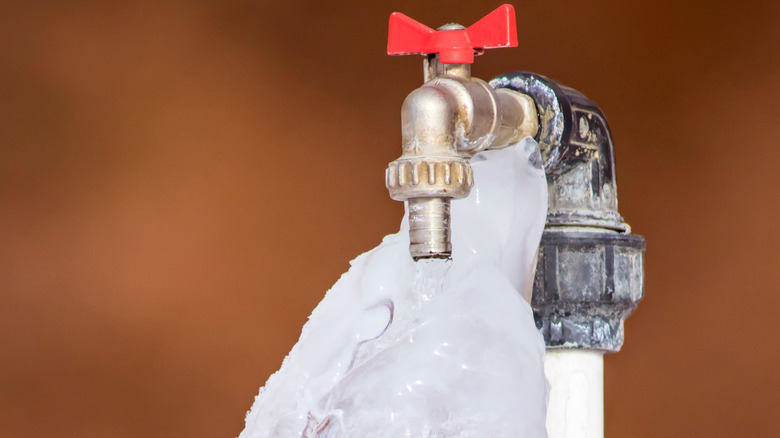Preventing Frozen Pipes in Cold Weather: Pro Advice
Preventing Frozen Pipes in Cold Weather: Pro Advice
Blog Article
Here on the next paragraphs you might get lots of high-quality information and facts in relation to 6 Ways to Prevent Frozen Pipes.

Cold weather can wreak havoc on your plumbing, particularly by freezing pipes. Here's just how to stop it from taking place and what to do if it does.
Intro
As temperature levels decrease, the risk of frozen pipelines boosts, potentially resulting in costly fixings and water damages. Understanding just how to avoid frozen pipelines is vital for property owners in cold environments.
Understanding Icy Pipes
What triggers pipes to ice up?
Pipelines freeze when revealed to temperature levels below 32 ° F (0 ° C) for extended durations. As water inside the pipes freezes, it expands, taxing the pipe wall surfaces and potentially causing them to burst.
Dangers and problems
Frozen pipes can bring about water system disturbances, property damages, and expensive fixings. Ruptured pipelines can flood homes and trigger extensive architectural damages.
Indicators of Frozen Water Lines
Identifying icy pipelines early can stop them from rupturing.
Exactly how to identify frozen pipes
Look for lowered water circulation from faucets, uncommon smells or noises from pipes, and visible frost on exposed pipes.
Prevention Tips
Shielding at risk pipelines
Cover pipes in insulation sleeves or make use of warmth tape to secure them from freezing temperatures. Focus on pipelines in unheated or exterior locations of the home.
Heating strategies
Keep indoor spaces adequately warmed, especially locations with pipes. Open cupboard doors to permit warm air to distribute around pipelines under sinks.
Safeguarding Exterior Pipes
Garden hose pipes and exterior taps
Disconnect and drain yard tubes prior to winter. Install frost-proof faucets or cover outside taps with insulated caps.
What to Do If Your Pipes Freeze
Immediate actions to take
If you suspect icy pipes, maintain taps open to eliminate stress as the ice thaws. Make use of a hairdryer or towels soaked in warm water to thaw pipelines gradually.
Long-Term Solutions
Architectural adjustments
Take into consideration rerouting pipelines away from outside wall surfaces or unheated areas. Include added insulation to attics, cellars, and crawl spaces.
Updating insulation
Purchase high-quality insulation for pipes, attic rooms, and walls. Correct insulation assists maintain regular temperatures and reduces the danger of frozen pipelines.
Conclusion
Protecting against frozen pipelines requires positive measures and fast feedbacks. By comprehending the reasons, signs, and preventive measures, home owners can safeguard their plumbing throughout winter.
5 Ways to Prevent Frozen Pipes
Drain Outdoor Faucets and Disconnect Hoses
First, close the shut-off valve that controls the flow of water in the pipe to your outdoor faucet. Then, head outside to disconnect and drain your hose and open the outdoor faucet to allow the water to completely drain out of the line. Turn off the faucet when done. Finally, head back to the shut-off valve and drain the remaining water inside the pipe into a bucket or container. Additionally, if you have a home irrigation system, you should consider hiring an expert to clear the system of water each year.
Insulate Pipes
One of the best and most cost-effective methods for preventing frozen water pipes is to wrap your pipes with insulation. This is especially important for areas in your home that aren’t exposed to heat, such as an attic. We suggest using foam sleeves, which can typically be found at your local hardware store.
Keep Heat Running at 65
Your pipes are located inside your walls, and the temperature there is much colder than the rest of the house. To prevent your pipes from freezing, The Insurance Information Institute suggests that you keep your home heated to at least 65 degrees, even when traveling. You may want to invest in smart devices that can keep an eye on the temperature in your home while you’re away.
Leave Water Dripping
Moving water — even a small trickle — can prevent ice from forming inside your pipes. When freezing temps are imminent, start a drip of water from all faucets that serve exposed pipes. Leaving a few faucets running will also help relieve pressure inside the pipes and help prevent a rupture if the water inside freezes.
Open Cupboard Doors
Warm your kitchen and bathroom pipes by opening cupboards and vanities. You should also leave your interior doors ajar to help warm air circulate evenly throughout your home.

Hopefully you liked our article on Preventing and dealing with frozen pipes. Thanks so much for spending some time to read our blog post. If you please take the opportunity to distribute this post if you enjoyed reading it. Thanks for your time spent reading it.
Call Today Report this page